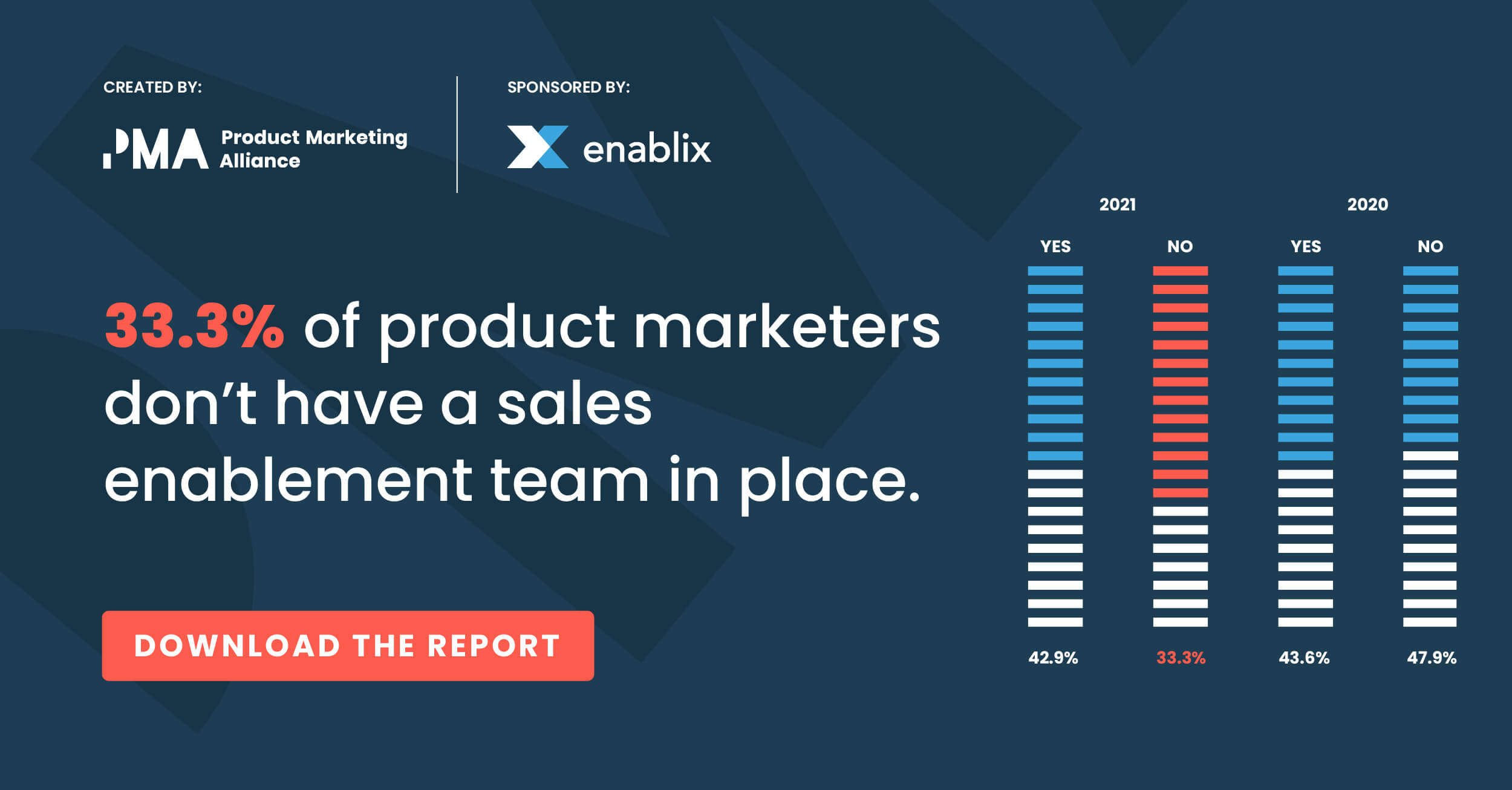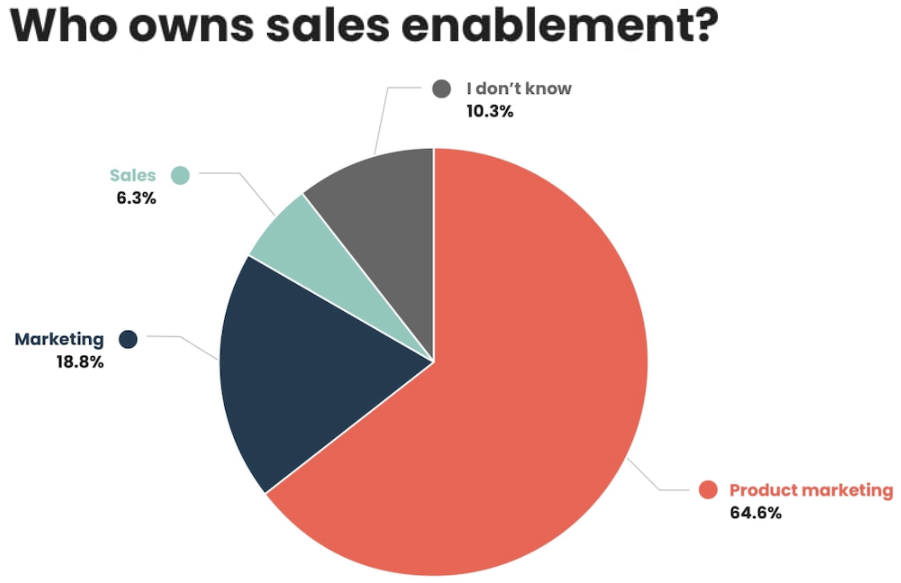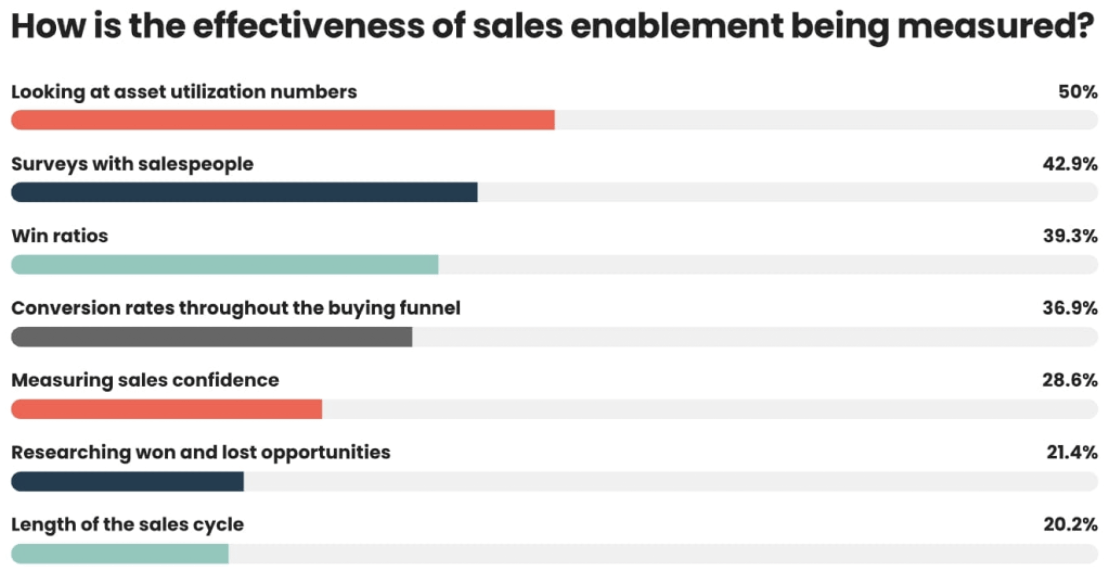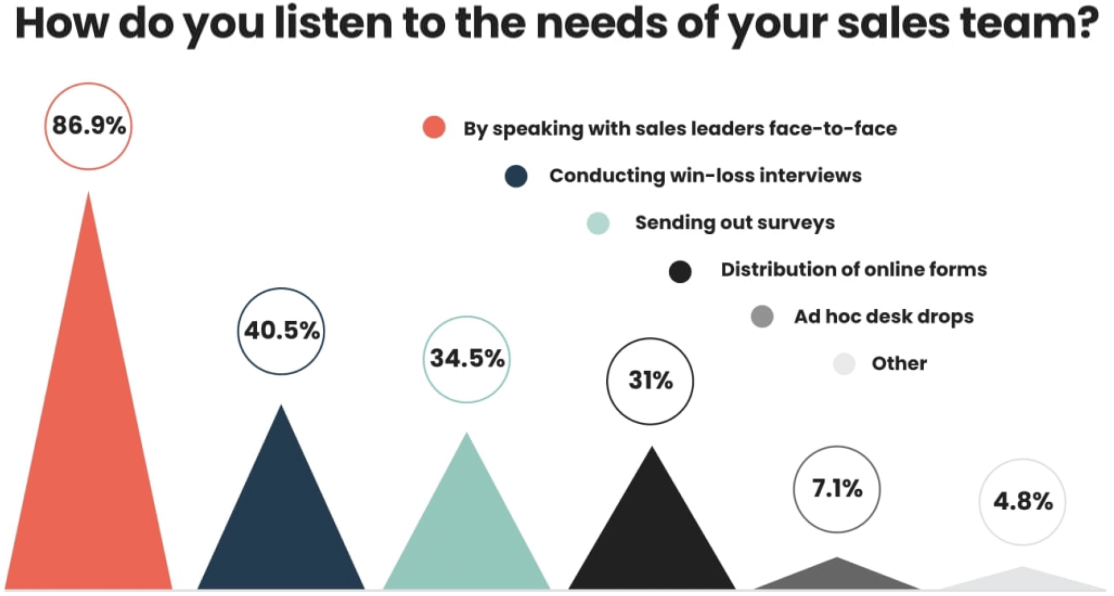Takeaways From PMA's 2021 Sales Enablement Landscape Report


It’s here: the Product Marketing Alliance has released their 2021 Sales Enablement Landscape Report.
The second annual report is the result of surveying hundreds of product marketing leaders on everything enablement, such as:
- Who owns sales enablement?
- How much of the product marketing role is focused on sales enablement?
- Is product marketing responsible for creating sales assets?
We’ve recapped a few important takeaways below, but trust us - you’re going to want to get the real thing. Download the Report Here!
Sales Enablement is blowing up
Last year, almost half of the people surveyed** (47.9%)said they didn’t have a sales enablement team in place - and had no plans to introduce one. This figure has decreased to 33.3%**in this year’s report.  This is an encouraging stat because it shows that companies are beginning to recognize what has been true all along - no matter what you call it, nearly all companies are doing some form of sales enablement. While 67% of companies today have an official sales enablement team, we expect this number to continue to rise as companies realize the benefits of putting these programs in place.
This is an encouraging stat because it shows that companies are beginning to recognize what has been true all along - no matter what you call it, nearly all companies are doing some form of sales enablement. While 67% of companies today have an official sales enablement team, we expect this number to continue to rise as companies realize the benefits of putting these programs in place.
Product Marketing is in the Driver’s Seat
64.6%of product marketers said they own sales enablement at their company, a considerable increase from 2020** (23.4%)**.  This is an encouraging stat because it shows that companies are beginning to recognize what has been true all along - no matter what you call it, nearly all companies are doing some form of sales enablement. While 67% of companies today have an official sales enablement team, we expect this number to continue to rise as companies realize the benefits of putting these programs in place.
This is an encouraging stat because it shows that companies are beginning to recognize what has been true all along - no matter what you call it, nearly all companies are doing some form of sales enablement. While 67% of companies today have an official sales enablement team, we expect this number to continue to rise as companies realize the benefits of putting these programs in place.
Marketing Asset Utilization Reigns King
_When asked “How is the effectiveness of sales enablement being measured?”,__50%_of the respondents replied with measuring asset utilization, while _43%_found surveys most helpful and _39%_using sales win ratios.  When your job is to enable sales to sell better, how do you measure your effectiveness? It’s a tricky question - and from the results we can tell that the industry hasn’t settled in on a single method to measure efficacy yet. But in the absence of hard key results to measure SE teams by, asset utilization and internal surveys lead the pack. We agree that unless you have hard before-and-after numbers from starting your sales enablement practice, these are great numbers to measure - as those insights will be valuable.
When your job is to enable sales to sell better, how do you measure your effectiveness? It’s a tricky question - and from the results we can tell that the industry hasn’t settled in on a single method to measure efficacy yet. But in the absence of hard key results to measure SE teams by, asset utilization and internal surveys lead the pack. We agree that unless you have hard before-and-after numbers from starting your sales enablement practice, these are great numbers to measure - as those insights will be valuable.
Quantitative Feedback is Hard to Get
86.9%of product marketers we spoke with said they get feedback from sales reps by speaking with them face to face.  Face-to-face feedback is a double-edged sword: While it gives the advantage of an engaged and responsive sales rep, it will often miss out on the kinds of in-the-moment critical feedback that reps often forget once the meeting is over. We believe that a more sustainable model is that PMM’s continue to focus on continued discussion with individual sales members, building in quick and easy feedback mechanisms to sales’ workflow will give immeasurably valuable pieces of information that you may not get in an interview after the fact.
Face-to-face feedback is a double-edged sword: While it gives the advantage of an engaged and responsive sales rep, it will often miss out on the kinds of in-the-moment critical feedback that reps often forget once the meeting is over. We believe that a more sustainable model is that PMM’s continue to focus on continued discussion with individual sales members, building in quick and easy feedback mechanisms to sales’ workflow will give immeasurably valuable pieces of information that you may not get in an interview after the fact.
Other quick hits:
Most of the product marketers surveyed** 39.4%hold sales enablement meetings when they’re due to launch a new product, and the majority assess the quality of their sales enablement sessions on a monthly basis. Similar to the face to face discussion above, these kickoff meetings are great ways to get sales teams excited and motivated to go pitch new products and solve new problems. However, the most meaningful education should be continuous and ongoing. Do they know where the latest data sheet is for the new product - or where they can find a case study of someone using it? This “continuous” sales enablement is critical to the success of a new product, but is sadly overlooked by many PMM’s as they focus on the next product launch. When we asked how engaged sales representatives are on a scale of 1-10, the average response rate was 6.1** , a decrease of** 1.9** from 2020, when on average, respondents answered** 8** . 365 days and 1000 hours of zoom meetings are definitely going to take it out of a team. Add on top of that the fact that we are currently in a sales content peak post-COVID, and it’s easy to understand why teams may seem less engaged today than they have been in the past. Our advice? Don’t force it, but bring attention to the success that increased engagement brings. Sales reps will pay as much attention as they feel they need to to get to their quota, all you can do is provide the resources they need to be successful. And if they’re successful without engaging? Then you need to figure out what their secret is and how to scale that across the organization. 94%of product marketers surveyed said they’re responsible for creating sales enablement assets. No surprises here, but this stat does not paint the complete story. While on the surface it may seem that much of product marketing’s job is creating sales content, we think you’d see similar numbers if you polled marketing, customer success, or product management teams as well. In the world of remote content-based sales, we consistently see members of every team, not just product marketing, being responsible for creating sales collateral. Interested in the research, or have feelings on any of our takeaways? Let us know @Enablix.